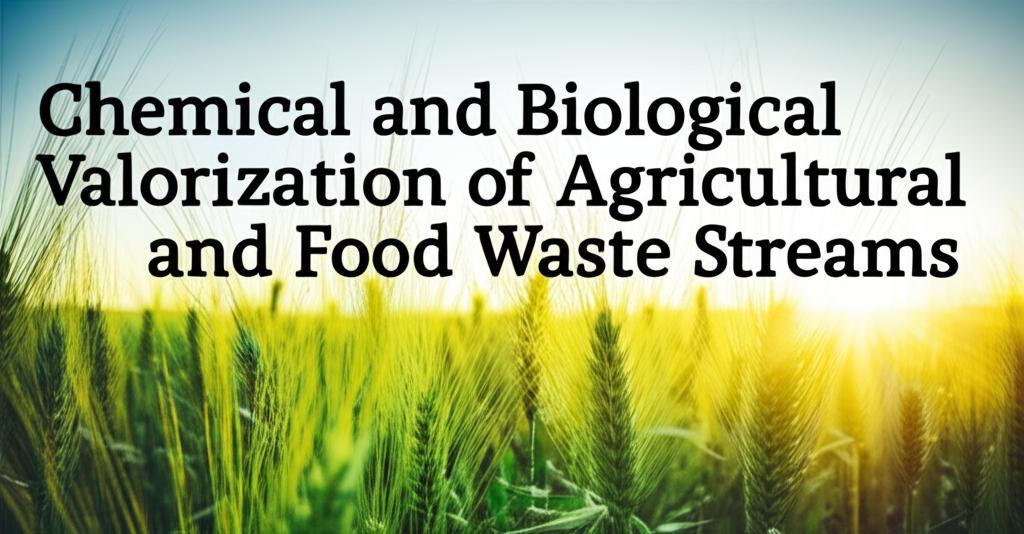Agricultural and food waste streams represent a significant global challenge, contributing to environmental pollution and economic losses. However, these streams are increasingly viewed not as waste, but as abundant, renewable resources rich in valuable components. Chemical and biological valorization techniques are at the forefront of transforming these residues into higher-value products, aligning with circular economy principles and sustainable development goals.
Valorization is the process of converting waste materials or byproducts into more useful products, including chemicals, materials, and fuels. This approach offers substantial benefits by reducing the burden on landfills, mitigating greenhouse gas emissions associated with decomposition, and creating new economic opportunities from materials previously discarded. It addresses environmental concerns while unlocking the potential of biomass components like lignocellulose, proteins, fats, starches, and various bioactive compounds.
Chemical Valorization PathwaysChemical methods employ various reactions and processes to break down and transform waste components. Key techniques include:
- Extraction: Isolating specific high-value compounds like antioxidants, pigments, essential oils, polyphenols, and pectin using various solvents, sometimes enhanced by techniques like ultrasound or microwaves. Green extraction methods using eco-friendly solvents like deep eutectic solvents are gaining interest.
- Thermochemical Conversion: Processes like pyrolysis, gasification, and hydrothermal liquefaction use heat to convert biomass into bio-oil, syngas (a mixture of hydrogen and carbon monoxide), and biochar. These intermediates can be further refined into biofuels, chemicals, or soil amendments.
- Hydrolysis: Using acids, alkalis, or catalysts to break down complex carbohydrates (like cellulose and hemicellulose) into simpler sugars, which can then be used in fermentation processes.
These chemical routes can yield platform chemicals, biofuels, materials precursors, and specialized functional ingredients for various industries.
Biological Valorization PathwaysBiological methods leverage the metabolic activities of microorganisms (bacteria, yeasts, fungi) or enzymes to convert organic waste into desired products. Prominent approaches include:
- Anaerobic Digestion (AD): Microorganisms break down organic matter in the absence of oxygen, producing biogas (primarily methane and carbon dioxide) for energy generation and digestate, a nutrient-rich residue usable as biofertilizer. Recent focus includes optimizing AD to maximize the production of volatile fatty acids (VFAs).
- Fermentation: Using specific microbial strains to convert sugars or other organic compounds into products like bioethanol, organic acids (lactic acid, succinic acid), enzymes, and bioplastics like polyhydroxyalkanoates (PHAs). Dark fermentation is specifically used to produce VFAs and biohydrogen.
- Enzymatic Conversion: Employing isolated enzymes (free or immobilized) to selectively break down specific components, such as cellulases for cellulose hydrolysis or lipases for fat processing. This offers high specificity but can require optimization for cost-effectiveness.
Biological processes are often well-suited for wet waste streams common in the food industry and can operate under milder conditions than many chemical processes.
Integrated Approaches and BiorefineriesMaximizing resource recovery often involves integrating multiple valorization techniques. The biorefinery concept applies this by combining various processes (chemical, biological, thermal) in sequence or parallel to convert biomass into a wide spectrum of products, similar to how a petroleum refinery produces multiple fuels and chemicals. For example, a lignocellulosic waste might first undergo pretreatment (chemical or physical), followed by enzymatic hydrolysis (biological) to release sugars, which are then fermented (biological) into biofuels or biochemicals, while the lignin residue might be converted via thermochemical routes. Integrated systems aim to utilize almost all fractions of the waste stream, enhancing overall efficiency and economic viability.
Value-Added Products from Agri-Food WasteThe range of products derivable from agricultural and food waste is vast and includes:
- Bioenergy: Biogas, bioethanol, biodiesel, bio-oil, syngas.
- Biochemicals: Organic acids (e.g., lactic, succinic), platform chemicals, solvents.
- Biomaterials: Bioplastics (e.g., PHAs, polylactic acid), bio-based composites, bio-nanocomposites.
- Bioactive Compounds: Antioxidants, polyphenols, carotenoids, essential oils, vitamins, dietary fibers for use as nutraceuticals or functional food ingredients.
- Animal Feed: Protein-rich fractions or fermented products.
- Biofertilizers: Compost, digestate from AD.
- Enzymes: Industrially relevant enzymes produced via fermentation.
While significant progress has been made, challenges remain in optimizing pretreatment methods, improving conversion efficiencies, scaling up processes economically, and ensuring consistent product quality despite feedstock variability. Future research focuses on developing more efficient and robust microbial strains and enzymes, exploring novel green chemical catalysts and solvents, enhancing VFA recovery technologies, refining integrated biorefinery designs, and utilizing nanotechnology and advanced biotechnological tools to improve process stability and product applications.
The chemical and biological valorization of agricultural and food waste is crucial for transitioning towards a sustainable, circular bioeconomy. By transforming waste into valuable resources, these technologies offer pathways to reduce environmental impact, enhance food system sustainability, and generate economic value.

